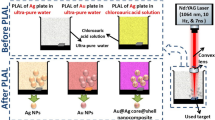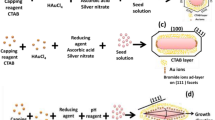Abstract
Using a seed–growth method, chemical reduction in aqueous solution was used to create gold nanoparticles (AuNPs). As seeds, AuNPs have been created and used as a nucleating agent with regard to the gold colloids’ anisotropic growth. The various seed quantities were added to the gold chloride-containing growth solution, and NPs have started to grow as a result. Au seeds are typically 20 nm in spherical and size in shape, while gold is 25–30 nm in size and spherical in shape. Peak absorption from nanospheres was measured between 535 nm and 530 nm. The surface plasmon band’s absorption peaks moved to the short wavelength region. AuNPs are doped with PMMA to create thin films that can be used as saturation absorbers (passive Q-switching) for Q-switching in visible region and green LEDs at various frequencies in the RhB fluorescence region. Those properties include the suitability of the resulting NPs for optoelectronic applications.













Similar content being viewed by others
Data availability
Data sharing is not applicable to this article as no datasets were created or analyzed during the current study.
References
P. Prajapati, Y. Shah, D. Sen, Gold nanoparticles: a new approach for cancer detection. J. Chem. Pharm. Res. 2(1), 30–37 (2010)
C. Rao, A. Muller, A. Cheetham, The chemistry of nanomaterials: synthesis, properties and application, Book (2004)
S. Zainab. Sadeq, N. Athera, A. Ali, S.S. AL-Awadi, Synthesis of gold nanoparticle in the form of paper willow by hot chemical reduction method, Int. J. Curr. Eng. Technol. 5(5) (2015)
V. Sharma, K. WeanPark, M. Surinivasarao, Colloidal dispersion of gold nanorods, historical background, optical properties, seed mediated synthesis, shape separation and self-assembly. Mater. Sci. Eng. 65, 1–38 (2009)
G. Schmid, B. Corain, Nanoparticle gold: synthesis, structure, electronic and reactivities. Eur. J. Inorg. Chem 17, 3081–3098 (2003)
N. Hanzic, T. Jurkin, A. Maksmovic, M. Gotic, the synthesis of gold nanoparticles by citrateradiolytical method. J. Radiat. Phys. Chem. 106, 77–82 (2015)
A. Ashkarran, seed mediated growth of gold nanoparticle based on liquid Arc discharge. Plasma Sci. Technol. 15(4), 376–381 (2013)
A. Sunatkari, S. Talwatkar, Y. Tamgadge, G. Muley, synthesis, characterization and optical properties of L-Arginine stabilized gold nanocolloids. J. Nanosci. Nanotechnol. 5(2), 30–35 (2015)
F.A.H. Mutlak, M. Jaber, H. Emad, Effect of laser pulse energy on the characteristics of au nanoparticles and applications in medicine. Iraqi J. Sci. 58(4C), 2364–2369 (2017)
M. Murawska, A. Skrzypczak, M. Kozak, Structure and morphology of gold nanoparticles in solution studied by TEM SAXS and UV-Vis. ACTA Physicapolonica 121(4), 888–892 (2012)
M. Daniel, D. Astruc, gold nanoparticles: assembly, supramolecular chemistry, quantum-size related properties and application toward biology, catalysis and nanotechnology. Chem. Rev. 104(1), 293–346 (2004)
J. Chen, Seed-mediated synthesis, functionalization, alignment and characterization of gold nanorods, Kent State University, M.Sc thesis (2012)
H.R. Humud, M.M. Dawood, Effect of Ag nanoparticles on R6G laser dye hosted by PMMA polymerized by plasma jet. Iraqi J. Phys. 14(29), 27–36 (2016)
AA. Moahmmed Ali Mohammed A. Hameed, Fabrication of solid random gain media in visible region from rhodamine dye solutions containing highly pure titanium dioxide nanoparticles. Iraqi J. Appl. Phys. 18(1), 3–8 (2022)
H. Cramer, L. Giri, M. Griep, S. Karna, Shape controlled gold nanoparticle synthesis, Army Res. Lab., pp. 1–24 (2013)
C. Ward, R. Tronndorf, A. Euster, M. Auad, E. Davis, Seed–mediated growth of gold nanorods: limits of length to diameter ratio control, J. Nanomater., pp. 1–7 (2014)
W. Leng, P. Patiand, P. Vikesland, Room temperature seed mediated growth of gold nanoparticles: mechanistic investigations and life cycle assessment. Environ. Sci. Nano 2(5), 440–453 (2015)
P. Dobrowolska, A. Krajewska, M. Gajda, B. Bartosewicz, P. Nyga, B. Jakiewics, Application of Turkevich method for gold nanoparticles synthesis to fabrication of SiO2 & Au and TiO2 & Au coreshell nanostructures. J. Mater. 8, 2849–2862 (2015)
B. Busbee, S. Obare, C. Murphy, an improved synthesis of high aspect ratio gold nanorode. Adv. Mater. 15(5), 414–416 (2003)
P. Jain, X. Huang, I. El-sayed, M. El-sayed, Nobel metal on the nanoscale: optical and photothermal properties and some applications in imaging, sensing, biology and medicine. ACC. Chem. Res 41(12), 1578–1586 (2008)
C. Louis, O. Pluchery, Gold nanoparticles for physics, chemistry and biology. (Imperial College Press, London, 2012)
N. Jana, L. Gearheartand, C. Mrphy, Evidence for seed-mediated nucleation in the chemical reduction of gold salts to gold nanoparticles. Chem. Mater 13(7), 2313–2322 (2001)
A. Khan, R. Rashid, G. Murtaza, A. Zahra, gold nanoparticles: synthesis and application in drug delivery. Trop. J. Pharm. Res. 13(7), 1169–1177 (2014)
N.T.M. an, N.T.H. Lien, N.D.H, D.Q. Hoang, D.Q. Hoa, Improving the performance of gold-nanoparticle-doped solid-state dye laser using thermal conversion effect. Miner. Met. Mater. Soc. (2018)
A. Patterson, The Scherrer formula for X-ray particle size determination. Phys. Rev. 56(10), 978–982 (1939)
A.H. Kuptsov, G.N. Zhizhin, Handbook of Fourier transform Raman and infrared spectra of polymers, vol. 45, Elsevier, New York (1998)
L.J. Juszczak, Comparative vibrational spectroscopy of intracellular tau and extracellular collagen I reveals parallels of gelation and fibrillar structure. J. Biol. Chem. 279, 7395–7404 (2004)
W. Haiss, N.T.K. Thanh, J. Aveyard, D.G. Fernig, Determination of size and concentration of gold nanoparticles from UV−Vis Spectra (2007)
M.A. Hameed, Effects of solvent properties on absorption and fluorescence characteristics of two organic dyes used as random gain media. Iraqi J. Appl. Phys. 17(2), 15–18 (2021)
M.R. Hashem, M.A. Hameed, High-purity narrow emission line display of titanium dioxide nanoparticles in laser dyes as random gains. Int. J. Light Electron. Opt. 260, 169058 (2022)
Funding
The authors have not disclosed any funding.
Author information
Authors and Affiliations
Contributions
Each co-author has made unique contributions to the work. The author AAHA prepared the thin films and contributed to writing the article draft. He wrote the program for optical properties and contributed to the analysis of the results. As the author FAHM, he supervised the work and reviewed the article draft.
Corresponding author
Ethics declarations
Competing interests
The authors have not disclosed any competing interests.
Ethical approval
The authors would like to declare that they do not have any conflict of interests.
Additional information
Publisher's Note
Springer Nature remains neutral with regard to jurisdictional claims in published maps and institutional affiliations.
Rights and permissions
Springer Nature or its licensor (e.g. a society or other partner) holds exclusive rights to this article under a publishing agreement with the author(s) or other rightsholder(s); author self-archiving of the accepted manuscript version of this article is solely governed by the terms of such publishing agreement and applicable law.
About this article
Cite this article
Al Hasan Hatem Ali, A., A-H.Mutlak, F. Synthesis and characterization of Au Nanoparticles by seed–growth method use as saturation absorber for visible laser Q-switched pulse generation. J Opt 53, 1598–1608 (2024). https://doi.org/10.1007/s12596-023-01337-0
Received:
Accepted:
Published:
Issue Date:
DOI: https://doi.org/10.1007/s12596-023-01337-0




